| WAT SRI PHO (วัดศรีโพธิ์) |
| Wat Sri Pho or the Monastery of the Magnificent Bodhi Tree was located off the city island in the northern area at Khlong Sra Bua sub-district, Mu 2. The temple was situated on the west bank of Khlong Sra Bua in an area called Thung Khwan. Wat Phrom Kalayaram stood in the north, Wat Phra Ngam in the west and Wat Khai Wua in the south. Wat Bailo and Wat Klang lie on the opposite side of the Sra Bua canal. Following an inscription inside the new ordination hall (left wall) a certain Thao Phrom Kankhan built this temple in 1749 during King Borommakot's reign (r. 1733-1758) in 1749. The temple received officially its bai sema or boundary stones in the year 1757. The temple site, at par with Wat Phrom Kalayaram, was occupied by the Burmese army in the last Burmese-Ayutthaya war of 1766-1767. The story goes that many Burmese soldiers were killed on the site due to a heavy cannon fire from the city. The temple was left void of Buddhist clergy after the war. The adjacent Wat Sri Pho and Wat Phra Kalayaram were fused in 1942. A new ubosot was built on the ruins of the old ubosot of Wat Phrom Kalayaram and the whole complex received the name Wat Mai Sri Pho (The word 'Mai' meaning 'new'). The ubosot or ordination hall is built in a mixed Late Ayutthaya and Ratanakosin style. The roof is three-tiered while the extended roof over the elevated porches is two tiered. The hall can be accessed by two entries on the west and east sides. The north and south sides have each five windows. The inside walls of the hall are nicely painted with the 'Jataka' tales (1). In the ubosot are very fine old Buddha statues dating from the Lopburi, Sukhothai and Ayutthaya period. A chedi stands in front of the ubosot, instead of being positioned at the west of the hall. The chedi was likely a restored satellite chedi of Wat Phrom Kalayaram; the original probably vanished in time. Wat Mai Sri Pho has a quite large surface, which is an indication of the former merging of Wat Sri Pho and Wat Phrom Kalayaram. The site is mentioned on Phraya Boran Rachathanin's map drafted in 1926 and located in geographical coordinates: 14° 22' 12.31" N, 100° 33' 27.65" E. Footnotes: (1) The Jataka tales (Th: chadok) refer to a voluminous collection of folklore-like literature native to India concerning the previous incarnations of the Buddha Siddhartha Gautama, both in human and animal form. The tales were originally written in Pali and dated between 300 BC and 400 AD. The canonical book itself comprises 547 poems, arranged roughly by increasing number of verses. Many of the tales are set in or near Benares (Varanasi), a city in north central India on the Ganges River. One of the world's oldest cities, Varanasi is the most sacred place for Hindus. Buddhists and Muslims also have important religious sites nearby. According to tradition, Buddha began his teaching at Sarnath a short distance from this city. |

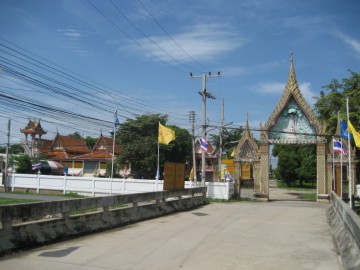
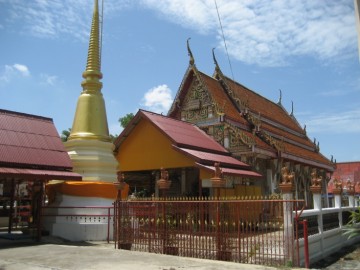
| Text, maps & photographs by Tricky Vandenberg - March 2010 Updated July 2015 |
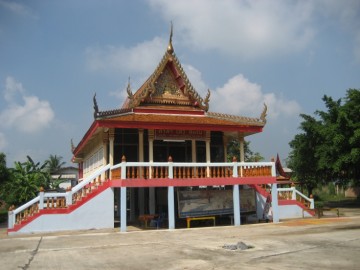
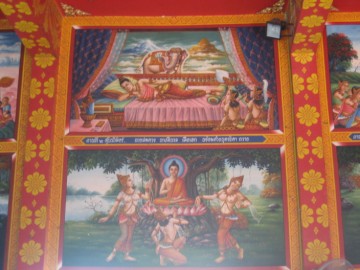
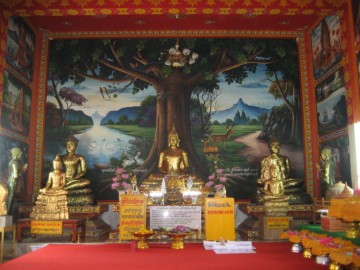
| (View of entry gate from Khlong Sra Bua bridge) |
| (Vihara on ancient premises of Wat Sri Pho) |
| (New ordination hall) |
| (Buddha statues in the ordination hall) |
| (Mural paintings of the life of Siddhartha Gautama) |
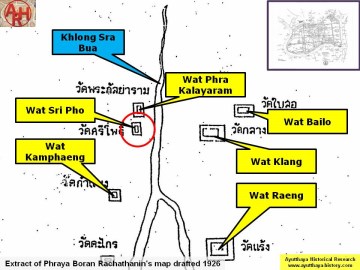
| (Detail of Phraya Boran Rachathanin's map - Anno 1926) |